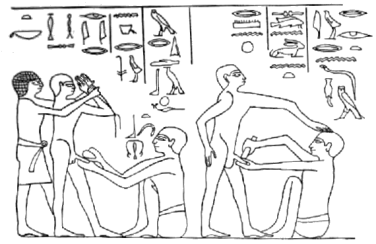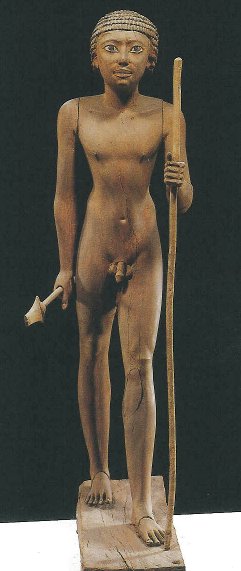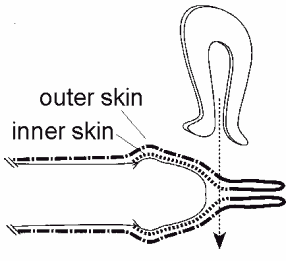Traditional Circumcision Worldwide
Circumcision is very ancient - the oldest recorded operation - and traditional circumcision is found worldwide, in Africa, Asia, Oceania and the Americas.

Circumcision 5,000 years ago.
Drawing of the relief at the tomb of Ankh-ma-Hor, c3,000BC.
The younger boy on the left is being held by an assistant - the inscription says "Hold him so that he doesn't faint". The older boy on the right is judged capable to going through the ritual without support, but he is bracing himself firmly for the ordeal. (Reproduced from Rogers, 1973)
Ancient Egypt
Ancient Egyptians carried out a complete circumcision, with the foreskin totally removed, as this statue shows.
Statuette of Merire-hashetef, from the Egyptian Museum, Cairo, about 2230 BC. One of three models of Merire-hashetef placed in his tomb at his death. They show him at different stages of his life - this is the middle one and the largest, showing him as a young man. It is made of ebony and quite stunningly realistic. The statue of him as a boy is now in the British Museum, and that of him in the prime of life is in the Glyptothek, Copenhagen.
This was a provincial tomb, cut into a cliff face at Sedment, so Merire-hashetef was not a king or a member of the royal court. But he must have been a person of some importance locally. He was buried in a deep underground chamber; coffins with three female skeletons (his wives?) were in another chamber.
Courtesy Egyptian Museum, Cairo
|
 |
The simplest of all traditional methods is the tehe of the Polynesian islands and Phillipines. The foreskin is just cut lengthwise along the top, with nothing removed. A wooden spatula is placed under the foreskin, above the glans, to protect it. Then the foreskin is cut lengthways with a sharp stone, cutting down on to the sliver of wood. Since the cut runs along the entire length of the double layer of skin, the prepuce falls away leaving the entire knob exposed even though nothing has been removed. The outer skin heals to the inner on each side, so that when healing is complete there is a bare knob and a lot of loose floppy skin. Similar techniques are sometimes found in Indonesia and parts of Africa, though full circumcision is more common in those regions.
The traditional operation of the Tartars of Russian Central Asia takes this simplified approach one step further. With a knife and wooden pincers a triangular piece is cut from the upper side of the foreskin, leaving the knob exposed. Care is taken to ensure that the remaining skin does not flop over the glans again, since if it does the two sides of the foreskin may fuse together with scar tissue, re-uniting the skin over the glans. If this happens, tradition says that circumcision must be carrried out again.
In southern Africa the Xhosa carry out a full circumcision (Umkhwetha) with a technique which is probably representative of many in that part of the world. The circumcisor pulls the young man's foreskin forward, slipping it over his index finger like a glove and holding it in place with his thumb and middle finger. Stretching it tightly he cuts it around, cutting between his finger and the tip of the penis. The outer skin springs back down the shaft, and the remaining inner skin is pushed back down over the shaft to meet it. Special herbs are applied and a tight leather bandage staunches the bleeding.
The desert Arabs traditionally used a technique of constriction to minimise bleeding which has its counterparts in many modern surgical approaches. The foreskin was pulled forward as far as possible then tied up tightly with a cord. It was left like that for half an hour or so, then cut off in front of the knot. The string was then slipped off and the inner skin pushed back to meet the outer (which had, of course, sprung back once it was freed). Again the penis was bound up tightly to minimise bleeding, along with the operator's own idea of suitable medicament (which in most cases probably caused more infections than it prevented).

Use of the barzel in traditional Jewish circumcision
The Jews seem to have adopted circumcision from the Egyptians, and Jewish circumcision is believed to have once been similar to the Arab kind, with much of the inner skin left behind. However, for at least the past 2000 years a more elaborate procedure has been used. In a traditional Jewish circumcision the skin is first pulled forwards and cut off in front of the glans. This step is called chituch, and a guard called a barzel (like a spatula with a slit in it) may be slipped over the stretched skin to safeguard the glans. In the next stage, periah, the mohel (circumcisor) slits the inner skin (in ancient times using a sharpened fingernail) and cuts or tears it most of it away from around the base of the glans. In the past the mohel would then fill his mouth with wine (as an antiseptic) and suck the wound to remove surplus blood (mezizah). This is, of course, no longer done. The result is a very thorough circumcison with little surplus skin and often little or no visible scarring. An experienced mohel would carry out all of this very swiftly, and many accounts testify that there often seems to be little or no trauma to the child. For an analysis of the biblical account of the introduction of circumcision to the descendants of Abraham, follow the link below.
The fact that so many traditional societies have performed circumcisions in primitive conditions for so long is a dramatic demonstration of both its cultural simplicity and the low risk of the operation.
Home
Back
Top
Copyright (c) 2001, 2005


